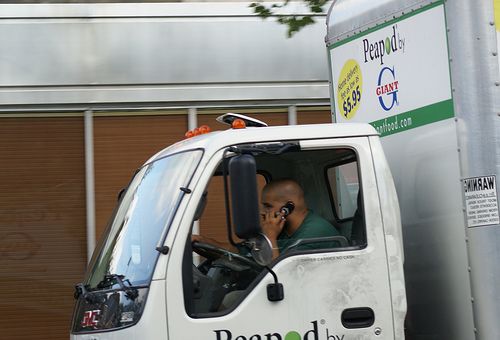After the sad story we heard from the U.K. on Monday on the results of texting behind the wheel and the ineffectual efforts of the New York State legislature to address distracted driving, it’s great to hear that the federal government is taking up the cause. The D.C. outpost of Streetsblog has a great post about the current discussion in Congress on what the bill should look like. s with any regulatory agenda in the U.S., there are two possible tracks: either implement a federally mandated ban or leave it as a state-by-state issue while applying pressure to ensure national change. The difference feels to me little more than symbolic, but it’s looking like if we go for the latter, the bill will likely capture the illusive beast of true widespread bi-partisan support.
Indeed, by following the state-by-state track, chair of the Senate Committee on Commerce, Science & Transportation Sen. Jay Rockefeller (D-W.V.) has secured three Republican co-sponsors on his recently introduced bill entitled the Distracted Driving Prevention Act of 2009. In his statement during the recent hearing entitled Combating Distracted Driving: Managing Behavioral and Technological Risks, Sen. Rockefeller outlined the dangers of drivers using cell phones:
At this very moment, 11 percent of all drivers on the road are holding an electronic device: They are calling home on their cell phone or reading a text from a friend; they are sending an email to the office on their Blackberry or looking up directions with a GPS system. That amounts to 812,000 distracted drivers at any given moment. 812,000 drivers focused on something other than the road. 812,000 drivers putting their own lives, their passengers’ lives — and the lives of everyone else on the road at risk.In September 2008, 13-year-old Margay Schee of Marion County, Florida was riding home on the school bus. A truck driver, who by his own admission was distracted by his cell phone, slammed into the back of the bus, stopped with its flashers on. The bus caught fire and Margay was killed. Her terrible story is just one of thousands. Last year, distracted drivers killed 5,800 people and injured 515,000. Deaths like Margay’s are absolutely devastating — and absolutely preventable.
The anti-cell phone campaign would look much like successful driver safety campaigns of the past, such as the mandatory use of seat belts and hard penalties for drunk-driving, that provided federal guidance but let states issue their own laws to enforce good behavior behind the wheel. And we can expect a national awareness campaign on the dangers of distracted driving much as we saw for seat belts and drunk driving. The big difference between these campaigns, however, was that seat-belts were promoted through the promise of additional funds as incentives while stricter drunk driving laws were encouraged though the threat to withhold highway funding to states if they did not comply. Looking back, it’s clear that the punitive strategy was far more effective and in fact did not result in any state losing federal highway funding. As it now stands, the Distracted Driving bill would go the seat-belt route rewarding states with additional grants for going along with the federal program, though some Senate Democrats are fighting to include a mix of incentives and disincentives that they feel will lead to better compliance.
I would think that during a recession in which so many states are teetering on the edge of bankruptcy, the promise of extra funding from the Feds would be enough to push through their own Distracted Driving bills. So really, whether the bill opts for a rewards- or punishment-based program, we should be seeing major progress in a pressing public safety issue.


_600_350_80_s_c1.jpg)













